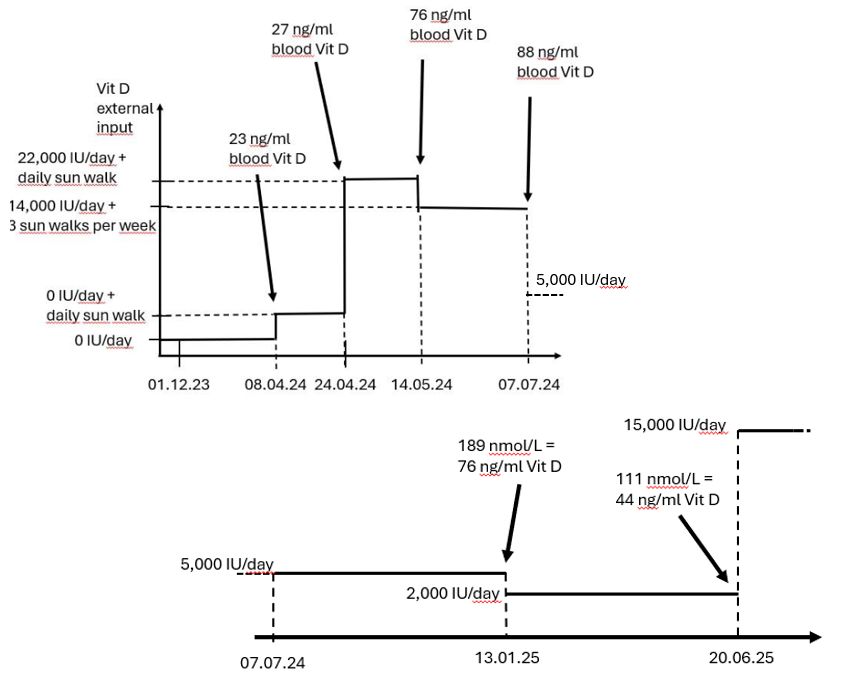- within Food, Drugs, Healthcare and Life Sciences topic(s)
- with readers working within the Technology, Media & Information and Pharmaceuticals & BioTech industries
It is a widespread belief that people living near the equator receive enough sun exposure to maintain healthy vitamin D levels—simply by walking outside. My experience over the past 1.5 years proves that this is a myth.
Even with regular midday sun exposure in Singapore, I saw that my vitamin D level only increased when I combined sun exposure with carefully planned supplementation. In this article, I share my experiment: maintaining optimal vitamin D levels over the long term.
Background: How I Got Here (Phase I and Phase II)
For many years, I have regularly checked my blood values. Most of the time, they were within acceptable ranges.
That changed after an accident in late 2023. I slipped in a puddle in our staircase and tore my left quadriceps tendon. This led to knee surgery and four months of limited mobility. I could not walk properly, lost all progress in strength training, and had to cancel my participation in the 2023 World Championship.
This immobile lifestyle had serious effects on my health. One of the most visible signs in my blood measurement was a low vitamin D level. After my recovery began in December 2023, I started to focus on this issue.
Phase I: Can Sunlight Alone Solve It?
Between December 2023 and April 2024, I tested whether walking in equatorial sun could raise my vitamin D. Every day, I walked 45 minutes at 12:30 p.m. in Singapore's strong sun, wearing shorts and a T-shirt, with no sunscreen.
After 21 days, my vitamin D increased only slightly—from 23.3 ng/mL to 27 ng/mL. This result was disappointing. Despite perfect timing and location, sun exposure alone was not enough.
I wrote an article about my journey in Phase I, here
https://ip-lawyer-tools.com/health-experiment-does-a-daily-45-minutes-walk-under-the-full-equator-sun-change-your-vitamin-d-level/
Phase II: High-Dose Supplementation
In April 2024, I started high-dose vitamin D₃ supplementation:
- For 3 weeks, I took 22,000 IU/day, and my level jumped to 76 ng/mL
- Then I reduced to 14,000 IU/day for 7 more weeks, reaching 88 ng/mL
I also added Vitamin K₂ (about 3,000 mcg/day) and Magnesium (about 800 mg/day) to reduce risks from high vitamin D intake. These results showed that targeted supplementation, combined with moderate sun exposure, could rapidly and safely increase vitamin D levels.
A little article about my phase II is found here
https://ip-lawyer-tools.com/health-experiment-part-ii-how-to-improve-your-vitamin-d-levels-when-you-live-at-the-equator/
With these two phases completed, I moved on to Phase III: long-term maintenance and understanding the relationship between dosage, blood levels, and supportive nutrients like magnesium.
The Setup for Phase III – From High Doses to Maintenance
After successfully raising my vitamin D level from a deficient state (27 ng/mL) to a strong "sufficient" range (88 ng/mL) in mid-2024, I transitioned into maintenance mode. I wanted to see what it takes to keep my levels stable without continuing extremely high supplement doses.
I split this phase into two periods:
Period 1: 07 July 2024 to 13 January 2025
- Vitamin D₃: 5,000 IU per day
- Walking: About 3 times per week at 12:30 p.m., 45 minutes per session
- Vitamin K₂: 1,000 micrograms per day
- Magnesium: 800 milligrams per day
The result was that my vitamin D level stayed more or less stable at 76 ng/mL, see here
![]()
This showed that 5,000 IU per day, coming from a high supply of more than 14,000 IU/day over a period of 3 months and together with moderate sun exposure and high-dose K₂ and magnesium, was effective in holding my blood levels more or less stable in an upper range.
Side note: my Magnesium level on 13 January 2025 was 0.79 mmol/L, which was a little bit too low.
A Note on Units: A Common Misunderstanding
I want to highlight an important detail that may confuse others as well: vitamin D levels are measured in two different units, depending on the lab or country. These units are:
- nmol/L (nanomoles per litre), used in many international laboratories
- ng/mL (nanograms per millilitre), used mainly in the United States
On 13 January 2025, I received my lab result, which showed a vitamin D level of 189 nmol/L. At first, I thought this was 189 ng/mL, which would be extremely high—possibly dangerous. For a moment, I was convinced that I had taken too much vitamin D for too long.
However, after checking more carefully, I realised the value on 13 January 2025 was in nmol/L, not ng/mL. The correct conversion is:
1 ng/mL = 2.5 nmol/L
Therefore, 189 nmol/L = 76 ng/mL
This is well within the healthy upper range.
"IU/day" stands for International Units per day.
An International Unit (IU) is a standardized measure used to describe the biological activity or effect of a substance, not its weight. It is commonly used for vitamins, hormones, and other substances where the effect, not the mass, is what matters.
So when you see "5,000 IU/day", it means:
You are taking a dose of vitamin D₃ each day that has the biological activity equivalent to 5,000 International Units.
This is different from milligrams (mg) or micrograms (mcg), which measure the actual weight of the substance.
For vitamin D₃:
- 1 microgram (mcg) = 40 IU
- So, 5,000 IU/day = 125 mcg/day of vitamin D₃
Using IU makes it easier to compare the strength of different vitamin D products or dosing recommendations across brands and countries.
A Note on Vitamin D₂ vs. D₃
Not all forms of vitamin D are the same. There are two main types used in supplements and fortified foods: Vitamin D₂ (ergocalciferol) and Vitamin D₃ (cholecalciferol).
- Vitamin D₂ comes from plant and fungal sources, such as UV-treated mushrooms or yeast.
- Vitamin D₃ is produced in the skin after sun exposure and is found in animal-based foods such as fatty fish and egg yolk. Most high-quality supplements use D₃, either from lanolin (sheep wool) or vegan sources like lichen.
While both forms can raise blood levels of vitamin D, D₃ is more effective. It is better absorbed, remains longer in the body, and leads to a more stable increase in serum 25(OH)D levels. For these reasons, I have used Vitamin D₃ exclusively throughout my experiment.
If you are comparing supplement labels, always check that the product contains cholecalciferol (D₃)—not just "vitamin D."
How Much Vitamin D Is Safe?
Recommended intake levels vary depending on the source. I found Official guidelines (e.g. NIH) that say that 600–800 IU/day is required for adults. Other sources say that the upper safe limit: is 4,000 IU/day. And then I found sources that say that Weight-based calculations apply. For a person weighing 115 kg, which was my body weight in the second half of 2024, the estimated need is 115 kg × 60 IU = 6,900 IU/day. This is above public guidelines but it aligns with my own experience.
A Note on Vitamin K₂ Forms: MK‑4 vs MK‑7
Vitamin K₂ is not a single substance. It comes in several different forms, the most important being MK‑4 (menaquinone‑4) and MK‑7 (menaquinone‑7). These two forms behave very differently in the body.
- MK‑4 is found in animal-based foods and has a short half-life in the body. It is quickly absorbed but also quickly cleared.
- MK‑7 is found in fermented foods like natto and has a longer half-life, allowing for more stable blood levels with lower doses.
Because of these differences:
- MK‑4 requires higher daily doses—often in the range of 1,000 to 3,000 micrograms per day.
- MK‑7 is more bioavailable and effective at lower doses, usually 100 to 200 micrograms per day.
In my supplementation plan, I have used Vitamin K₂ in the MK‑4 form, which explains the higher dosage figures mentioned in this article. This is not unusual or excessive, but necessary due to the lower bioavailability and shorter activity of MK‑4.
When choosing a Vitamin K₂ product, it is important to check the form. Confusing MK‑4 with MK‑7 could lead to incorrect dosing. For anyone combining high-dose vitamin D₃ with K₂, understanding this difference is essential.
Period 2: 13 January to 20 June 2025
Because of that misinterpreted measurement result of 13 January 2025, I have severely reduced my Vitamin D intake, while keeping the Magnesium intake high and maintaining a reduced Vitamin K2 intake.
- Vitamin D₃: 2,000 IU per day
- Walking: About 3 times per week at midday
- Vitamin K₂: 100 micrograms per day
- Magnesium: 800 milligrams per day
The result was that my vitamin D level dropped sharply to 44 ng/mL (111 nmol/L).

This decline occurred despite continued sun exposure and the same magnesium intake. It showed that 2,000 IU per day is not enough to maintain high levels, even near the equator.
Side note: my Magnesium level on 20 June 2025 was still 0.79 mmol/L, despite the Magnesium intake 0f 0.8 g/day.
Measurement Data
I have put together the following diagram, which describes my 1.5-year-long experiment:

Observations and Lessons
I have gained several insights over the past 1.5 years of my health journey:
- Midday sun exposure alone is not sufficient, even at the equator. Without adequate supplementation, vitamin D levels will drop. This supports what recent research suggests: many people in sunny climates are still deficient.
- Magnesium and vitamin K₂ play a support role. Throughout this phase, I kept magnesium intake high (800 mg/day), but my magnesium blood level stayed low at 0.79 mmol/L. This may have limited vitamin D metabolism and storage.
- The body needs time and support to build and hold vitamin D. There appears to be a storage phase: vitamin D and magnesium must first fill tissue reserves before they are visible in the blood.
My New Plan
I aim for the following blood values:
- Vitamin D: around 100 ng/mL
- Magnesium: around 0.90 mmol/L
To reach these targets, I have adjusted my daily intake as follows:
- Vitamin D₃: 15,000 IU
- Vitamin K₂: 2,500 micrograms
- Magnesium: 1.2 grams
My next blood test is planned for Christmas 2025. Based on earlier data, I estimate that my true maintenance dosage lies between 12,000 and 17,000 IU per day. I will adjust accordingly. And keep you updated here.
Conclusion
The idea that equatorial sunlight alone is enough to maintain healthy vitamin D levels is a myth. Even with frequent sun exposure in Singapore, I needed carefully measured supplementation—especially for vitamin D₃, K₂, and magnesium—to reach and maintain optimal levels.
This experiment shows that supplement strategies must be adapted to individual needs and verified by regular testing. More is not always better, but too little is simply not enough.
Martin "Vitamin D" Schweiger
IP Lawyer Tools by Martin Schweiger
The content of this article is intended to provide a general guide to the subject matter. Specialist advice should be sought about your specific circumstances.

